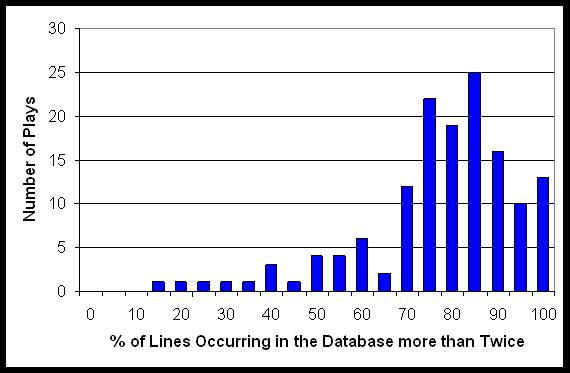"This is a Mummers’ play I wrote": Part 9 - Non-Rare Lines in Traditional Plays
Non-Rare Lines in Traditional PlaysIt may seem pointless to determine the percentage of traditional lines that appear in traditional plays, because surely the answers would always be 100%. However, only about 20% of line types occur more than twice in the database I prepared for my PhD (P.T.Millington, 2002). These are what I class as "non-rare lines". The other 80% of line types represent localised, often transient accretions, sometimes derived from literary sources. Therefore by determining the percentage of non-rare lines in each traditional text it has been possible to plot a graph for traditional plays that is equivalent to Figure 8. This is shown Figure 10. The traditional database comprised 181 texts and fragments, of which 142 complete texts were selected for statistical analysis. The plays that were excluded consisted of compiled plays, literary parallels, fragmentary texts, and seemingly composed texts. Some of these were analysed separately. |
Usage of Non-Rare Lines in Traditional Plays |
|||||||||||||
 Fig.10 - Usage of Non-Rare Lines in the Traditional Play Database |
|||||||||||||
|
Most plays have more than 70% non-rare lines. I therefore suggest that the presence of a low proportion of non-rare lines is evidence that a play contains rewritten or newly composed material, and/or inclusions from literary sources. The following plays have less than 40% non-rare lines (listed least first):
Because of the low proportion of non-rare lines in these plays they clearly cannot be regarded as typical of the genre. Indeed Georgina Boyes (1985), among others, has been critical of earlier folk play scholars who gave too much emphasis to such plays during their theorising. The Ampleforth and Revesby plays above are two specific examples that she discusses. |
Usage in Exceptional Traditional PlaysKnown or suspected compiled Texts were excluded from the main analysis, but had 59%-90% non-rare lines. In The Peace Egg, compiled by J.H.Ewing (1884), the proportion was 63%. In Slight's (1836) Christmas: his Pageant Play... the proportion was 83%. These percentages seem reasonable for plays that have been compiled from two or more traditional texts. Four other plays excluded from the graph:
These texts show evidence of literary hands at work. In the case of the chapbooks, new versions were probably produced for commercial reasons. The Papa Stour text is another of the atypical plays discussed by Georgina Boyes (1985). In publishing his Bampton text, J.A.Giles admitted that he had forgotten most of the words of the traditional play he recalled from his Somerset childhood, and had written the bulk of the text himself to fill the gaps. |